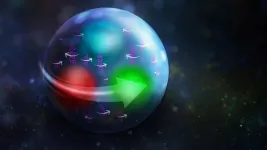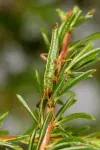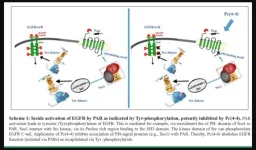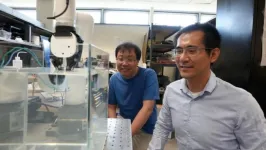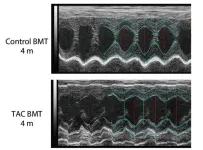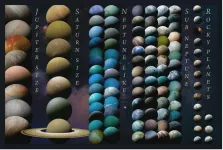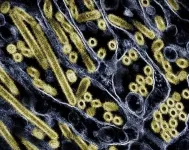(Press-News.org) NEWPORT NEWS, VA – Nuclear physicists have long been working to reveal how the proton gets its spin. Now, a new method that combines experimental data with state-of-the-art calculations has revealed a more detailed picture of spin contributions from the very glue that holds protons together. It also paves the way toward imaging the proton’s 3D structure.
The work was led by Joseph Karpie, a postdoctoral associate in the Center for Theoretical and Computational Physics (Theory Center) at the U.S. Department of Energy's Thomas Jefferson National Accelerator Facility.
He said that this decades-old mystery began with measurements of the sources of the proton’s spin in 1987. Physicists originally thought that the proton’s building blocks, its quarks, would be the main source of the proton’s spin. But that’s not what they found. It turned out that the proton’s quarks only provide about 30% of the proton’s total measured spin. The rest comes from two other sources that have so far proven more difficult to measure.
One is the mysterious but powerful strong force. The strong force is one of the four fundamental forces in the universe. It’s what “glues” quarks together to make up other subatomic particles, such as protons or neutrons. Manifestations of this strong force are called gluons, which are thought to contribute to the proton’s spin. The last bit of spin is thought to come from the movements of the proton’s quarks and gluons.
“This paper is sort of a bringing together of two groups in the Theory Center who have been working toward trying to understand the same bit of physics, which is how do the gluons that are inside of it contribute to how much the proton is spinning around,” he said.
He said this study was inspired by a puzzling result that came from initial experimental measurements of the gluons’ spin. The measurements were made at the Relativistic Heavy Ion Collider, a DOE Office of Science user facility based at Brookhaven National Laboratory in New York. The data at first seemed to indicate that the gluons may be contributing to the proton’s spin. They showed a positive result.
But as the data analysis was improved, a further possibility appeared.
“When they improved their analysis, they started to get two sets of results that seemed quite different, one was positive and the other was negative,” Karpie explained.
While the earlier positive result indicated that the gluons’ spins are aligned with that of the proton, the improved analysis allowed for the possibility that the gluons’ spins have an overall negative contribution. In that case, more of the proton spin would come from the movement of the quarks and gluons, or from the spin of the quarks themselves.
This puzzling result was published by the Jefferson Lab Angular Momentum (JAM) collaboration.
Meanwhile, the HadStruc collaboration had been addressing the same measurements in a different way. They were using supercomputers to calculate the underlying theory that describes the interactions among quarks and gluons in the proton, Quantum Chromodynamics (QCD).
To equip supercomputers to make this intense calculation, theorists somewhat simplify some aspects of the theory. This somewhat simplified version for computers is called lattice QCD.
Karpie led the work to bring together the data from both groups. He started with the combined data from experiments taken in facilities around the world. He then added the results from the lattice QCD calculation into his analysis.
“This is putting everything together that we know about quark and gluon spin and how gluons contribute to the spin of the proton in one dimension,” said David Richards, a Jefferson Lab senior staff scientist who worked on the study.
“When we did, we saw that the negative things didn't go away, but they changed dramatically. That meant that there's something funny going on with those,” Karpie said.
Karpie is lead author on the study that was recently published in Physical Review D. He said the main takeaway is that combining the data from both approaches provided a more informed result.
“We're combining both of our datasets together and getting a better result out than either of us could get independently. It's really showing that we learn a lot more by combining lattice QCD and experiment together in one problem analysis,” said Karpie. “This is the first step, and we hope to keep doing this with more and more observables as well as we make more lattice data.”
The next step is to further improve the datasets. As more powerful experiments provide more detailed information on the proton, these data begin painting a picture that goes beyond one dimension. And as theorists learn how to improve their calculations on ever-more powerful supercomputers, their solutions also become more precise and inclusive.
The goal is to eventually produce a three-dimensional understanding of the proton’s structure.
“So, we learn our tools do work on the simpler one-dimension scenario. By testing our methods now, we hopefully will know what we need to do when we want to move up to do 3D structure,” Richards said. “This work will contribute to this 3D image of what a proton should look like. So it's all about building our way up to the heart of the problem by doing this easier stuff now.”
-end-
Jefferson Science Associates, LLC, manages and operates the Thomas Jefferson National Accelerator Facility, or Jefferson Lab, for the U.S. Department of Energy's Office of Science. JSA is a wholly owned subsidiary of the Southeastern Universities Research Association, Inc. (SURA).
DOE’s Office of Science is the single largest supporter of basic research in the physical sciences in the United States and is working to address some of the most pressing challenges of our time. For more information, visit https://energy.gov/science
END
Up to 80% of breast cancer deaths occur in patients with tumors that express estrogen receptor-alpha. Although these estrogen receptor-positive (ER+) breast cancers often initially respond to standard treatment that combines endocrine therapies with CDK4/6 inhibitors, drug resistance often develops leading to lethal metastatic disease that spreads from the breast and does not respond to available treatments.
Looking to identify new vulnerabilities in this type of cancer that could lead to improved therapies, ...
“We have identified binding motifs within the C-tails of PAR1,2&4, indispensable for cancer growth and development.”
BUFFALO, NY- May 24, 2024 – A new editorial paper was published in Oncoscience (Volume 11) on April 25, 2024, entitled, “PH-binding motifs as a platform for drug design: Lessons from protease-activated receptors; PARs.”
While targeted cancer therapy is greatly dependent on specific oncogenic pathways or conferred by genetic alterations, it remains yet challenging and somewhat disappointing. The high level of failure relies ...
Undergoing surgery is seldom a pleasant experience, and it can sometimes be highly invasive. Surgical procedures have evolved steadily over the centuries, growing with the knowledge of anatomy and biology.
Innovative methods have also been bolstered with new tools, and a growth in the use of robotics since the 1980s has moved health care forward significantly. Assistant Professor Zhenhua Tian has pressed forward another step in the march of progress using robotics and noninvasive acoustics, and his team’s work has been published in Science Advances.
Robot-assisted surgery
Surgery using robots has been invasive since its invention because ...
LOGAN, UTAH, USA – A long-standing debate among evolutionary scientists goes something like this: Does evolution happen in a predictable pattern or does it depend on chance events and contingency? That is, if you could turn back the clock, as celebrated scientist Stephen Jay Gould (1941-2002) described in his famous metaphor, “Replaying the Tape of Life,” would life on Earth evolve, once again, as something similar to what we know now, or would it look very, very different?
“If you frame it as an either/or question, it’s too simplistic,” says Utah State University evolutionary biologist Zachariah Gompert. “The answer isn’t ‘completely ...
The stress of heart failure is remembered by the body and appears to lead to recurrent failure, along with other related health issues, according to new research. Researchers have found that heart failure leaves a “stress memory” in the form of changes to the DNA modification of hematopoietic stem cells, which are involved in the production of blood and immune cells called macrophages. These immune cells play an important role in protecting heart health. However, a key signaling pathway (a chain of molecules which ...
Scientists have pinpointed genetic changes that can leave children born with little to no immune defence against infection.
In a new study of 11 affected individuals, researchers from Newcastle University, the Wellcome Sanger Institute, the Great North Children’s Hospital, and their collaborators were able to link mutations in the NUDCD3 gene to Severe Combined Immunodeficiency and Omenn syndrome1 – rare and life-threatening immunodeficiency disorders. These mutations prevented the normal development of diverse immune cells needed to combat different pathogens2.
The findings, published today (24 May) in Science Immunology, ...
LAWRENCE — Using data from the Transiting Exoplanet Survey Satellite and W.M. Keck Observatory on Mauna Kea in Hawaii, an astronomer at the University of Kansas led a study appearing today revealing 15 new exoplanets — planets beyond our solar system — along with the mass of 126 other exoplanets. The findings give astronomers new understanding of the makeup of exoplanets and their star systems generally.
The study cataloging the exoplanets — comprising severe and exceptional environments, some of which hold promise to support life — was conducted under auspices of the TESS-Keck Survey and appears ...
WHAT:
Mice administered raw milk samples from dairy cows infected with H5N1 influenza experienced high virus levels in their respiratory organs and lower virus levels in other vital organs, according to findings published in the New England Journal of Medicine. The results suggest that consumption of raw milk by animals poses a risk for H5N1 infection and raises questions about its potential risk in humans.
Since 2003, H5N1 influenza viruses have circulated in 23 countries, primarily affecting wild birds and poultry with about 900 human cases, primarily among people who have had close contact with infected birds. In ...
Researchers at the U of A found self-identified small business owners on TikTok are circumventing a number of local, state and federal laws that restrict the individual sale of tobacco products. Specifically, the researchers found that 45% of the videos highlighted the fact that they did not require identification to verify the purchaser’s age.
“Many states have laws that govern procedures necessary to sell e-cigarettes,” explained lead researcher Page Dobbs, an associate professor of public health in the Department of Health, Human Performance and Recreation ...
Leading African scientists have issued a compelling call for more equitable research partnerships in a new paper published in Nature Medicine. The paper underscores the critical need for fair and collaborative research efforts to explore the unique and diverse microbiomes found in African populations and environments. Historically, these microbiomes have been underrepresented in global studies.
Over the past two decades, our understanding of the role played by the microbiome in different ecosystems has significantly expanded. For ...
